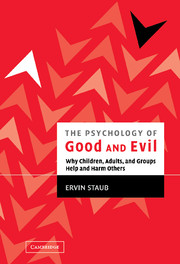Book contents
- Frontmatter
- Contents
- Preface
- Acknowledgments
- PART I INTRODUCTION AND CORE CONCEPTS
- PART II THE ROOTS OF HELPING OTHER PEOPLE IN NEED IN CONTRAST TO PASSIVITY
- PART III HOW CHILDREN BECOME CARING AND HELPFUL RATHER THAN HOSTILE AND AGGRESSIVE
- 10 The Origins of Caring, Helping, and Nonaggression: Parental Socialization, the Family System, and Cultural Influence
- 11 Natural Socialization: The Role of Experience or Learning by Doing
- 12 The Origins of Hostility and Aggression
- 13 Cultural–Societal Roots of Violence: Youth Violence
- 14 Bystanders and Bullying
- 15 Students' Experience of Bullying and Other Aspects of Their Lives in Middle School in Belchertown: Report Summary
- 16 Passive and Active Bystandership across Grades in Response to Students Bullying Other Students
- 17 Self-Esteem and Aggression
- 18 Father–Daughter Incest
- 19 Reducing Boys' Aggression: Learning to Fulfill Basic Needs Constructively
- 20 Creating Caring Schools: Design and Content of a Program to Develop Caring, Helping, Positive Self-Esteem, and Nonviolence
- PART IV THE ORIGINS OF GENOCIDE, MASS KILLING, AND OTHER COLLECTIVE VIOLENCE
- PART V THE AFTERMATH OF MASS VIOLENCE: TRAUMA, HEALING, PREVENTION, AND RECONCILIATION
- PART VI CREATING CARING, MORALLY INCLUSIVE, PEACEFUL SOCIETIES
- Appendix: What Are Your Values and Goals?
- Index
- References
17 - Self-Esteem and Aggression
Published online by Cambridge University Press: 07 May 2010
- Frontmatter
- Contents
- Preface
- Acknowledgments
- PART I INTRODUCTION AND CORE CONCEPTS
- PART II THE ROOTS OF HELPING OTHER PEOPLE IN NEED IN CONTRAST TO PASSIVITY
- PART III HOW CHILDREN BECOME CARING AND HELPFUL RATHER THAN HOSTILE AND AGGRESSIVE
- 10 The Origins of Caring, Helping, and Nonaggression: Parental Socialization, the Family System, and Cultural Influence
- 11 Natural Socialization: The Role of Experience or Learning by Doing
- 12 The Origins of Hostility and Aggression
- 13 Cultural–Societal Roots of Violence: Youth Violence
- 14 Bystanders and Bullying
- 15 Students' Experience of Bullying and Other Aspects of Their Lives in Middle School in Belchertown: Report Summary
- 16 Passive and Active Bystandership across Grades in Response to Students Bullying Other Students
- 17 Self-Esteem and Aggression
- 18 Father–Daughter Incest
- 19 Reducing Boys' Aggression: Learning to Fulfill Basic Needs Constructively
- 20 Creating Caring Schools: Design and Content of a Program to Develop Caring, Helping, Positive Self-Esteem, and Nonviolence
- PART IV THE ORIGINS OF GENOCIDE, MASS KILLING, AND OTHER COLLECTIVE VIOLENCE
- PART V THE AFTERMATH OF MASS VIOLENCE: TRAUMA, HEALING, PREVENTION, AND RECONCILIATION
- PART VI CREATING CARING, MORALLY INCLUSIVE, PEACEFUL SOCIETIES
- Appendix: What Are Your Values and Goals?
- Index
- References
Summary
Earlier in the book, I mentioned that aggressive behavior and low self-esteem have been found, in a variety of studies, to go together. In recent works, however, this relationship has been challenged. Here I will discuss some important characteristics of aggressive boys and men, including self-esteem.
Aggressive boys see other people as hostile, especially to themselves. They see others as intending to harm. For example, when they see pictures showing boys playing soccer and one boy kicking another while trying to get the ball away from him, they interpret this as intentional harmdoing (Coie & Dodge, 1997). Aggressive adults, both college students and prison inmates, also see other people as hostile (Galvin & Spielman, 1999). However, intentional rather than accidental harm caused by others is especially likely to provoke retaliatory aggression (Mallick & McCandless, 1966). Boys who are not aggressive assume that such acts are accidental. Some children who are badly treated, given their specific circumstances, may come to feel hostility and even hatred toward people. However, the need for connection to other people is profound, and even such children and the adults they grow into will desire and seek connection to some others.
Negative beliefs and hostility, as they come to be expressed in behavior, create a self-fulfilling prophecy. Reacting to others as if they had aggressed against us makes them respond aggressively. A group of unfamiliar boys, after spending a period of time with an aggressive boy, becomes aggressive toward him (Dodge, 1980).
- Type
- Chapter
- Information
- The Psychology of Good and EvilWhy Children, Adults, and Groups Help and Harm Others, pp. 244 - 247Publisher: Cambridge University PressPrint publication year: 2003



